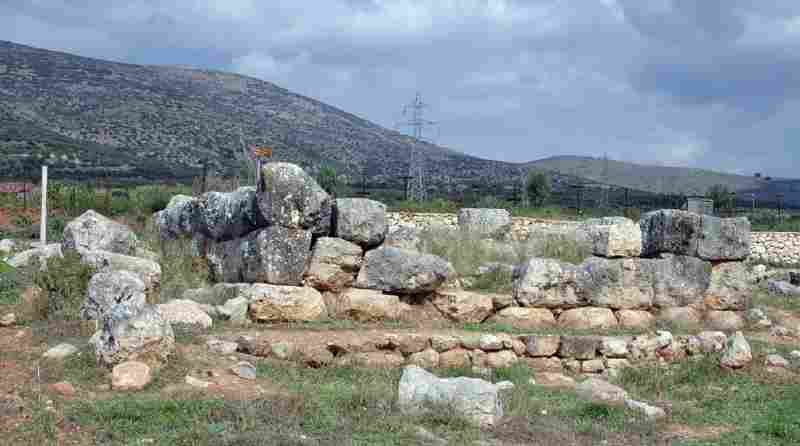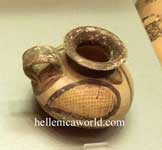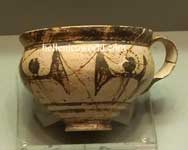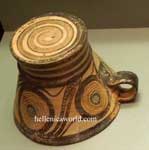Prosymna (Ancient Greek: Πρόσυμνα) was a town in ancient Argolis, in whose territory the celebrated Heraeum, or temple of Hera, stood.[1] Statius gives it the epithet "celsa."[2] Pausanias mentions only a district of this name.[3] According to Greek mythology, its name derives from a daughter of Asterion called Prosymna who, together with her sisters Acrea and Euboea, were wet-nurses of Hera.[3]
Archaeology

Prosymna , Photograph: Heinz Schmitz (www.outis.info)"
Archaeological Site

6745 : One-handled alabastron with racket decoration

6764 : One-handled hemispherical cup with double axes

7021 : Vapheio cup Prosymna
Aigeira - Akrotiri - Amorgos - Antikyra - Argos - Askitario - Athens - Cyprus - Delos - Eleusis - Elis - Epidaurus - Eretria - Karditsa - Keratea - Keros - Kozani - Lefkada - Lemnos - Lykosoura - Marmariani - Megara - Menidi - Milos - Mycenae - Naxos - Olympia - Orchomenos - Piraeus - Prosymna - Spata - Syros - Tanagra - Tegea - Thasos -Thebes - Thespiai - Tiryns -
National Archaeological Museum, Athens, Greece
The place was inhabited since the Neolithic period. In 1878, the area of ancient Prosymna, Panagiotis Stamatakis found a tomb in the form of a tholos that was built in the Mycenaean epoch and that was also reused in later periods. Archaeological investigations continued under the auspices of the Swedish Institute at Athens in the 1930s and then during the 1980s and 1990s that found two settlement areas on two different sides of the Mastos hill slope, belonging to the Early and Late Helladic Periods, respectively. They have found chamber tombs and large amounts of pottery that testify that the place was an important center of production of this material for many centuries. During the Hellenistic period and the early and late Roman the area also experienced a boom.[4][5]
References
Strabo. Geographica. viii. p.373. Page numbers refer to those of Isaac Casaubon's edition.
Statius, Theb. 4.44.
Pausanias. Description of Greece. 2.17.2.
Nicolás Platón (1981). La Civilization égéenne (in French). 2: Le Bronze récent et la civilization mycénienne. Paris: Albin Michel. p. 217. ISBN 2-226-01304-0.
Berbati en Argolis on the website of the Swedish Institute of Athens.
This article incorporates text from a publication now in the public domain: Smith, William, ed. (1854–1857). "Prosymna". Dictionary of Greek and Roman Geography. London: John Murray.
A - B - C - D - E - F - G - H - I - J - K - L - M-
N - O - P - Q - R - S - T - U - V - W - X - Y - Z
Retrieved from "http://en.wikipedia.org/"
All text is available under the terms of the GNU Free Documentation License
| Ancient Greece
Science, Technology , Medicine , Warfare, , Biographies , Life , Cities/Places/Maps , Arts , Literature , Philosophy ,Olympics, Mythology , History , Images Medieval Greece / Byzantine Empire Science, Technology, Arts, , Warfare , Literature, Biographies, Icons, History Modern Greece Cities, Islands, Regions, Fauna/Flora ,Biographies , History , Warfare, Science/Technology, Literature, Music , Arts , Film/Actors , Sport , Fashion --- |

